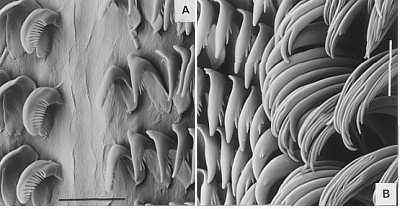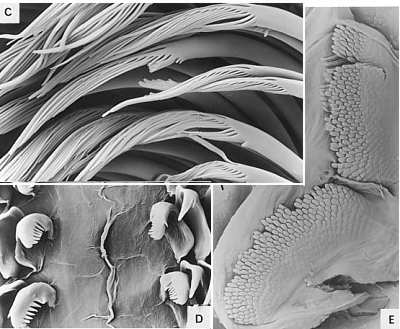

Rostanga arbutus
- Radula
PHOTO
From Figure 5. Rostanga arbutus, radular morphology of small specimens from northern New South Wales A, B (AM C81416), C (AM C152074), and Sydney D (AM C151168). A, Central region and inner right side; B, transition zone between inner right laterals and outer brush-like laterals; C, brush-like tips of outermost right lateral teeth; D, central region; E, chitinous lining of roof of buccal cavity flattened out to show jaw plates, anterior edge of jaw plates on left side, AM C125205. Scale bar = 30 µm in all cases, Photo G. J. Avern. [Rudman, W.B. & Avern, G.J. (1989). The genus Rostanga Bergh, 1879 (Nudibranchia: Dorididae) in the Indo-West Pacific. Zoological Journal of the Linnean Society 96: 281-338.]
Return to Rostanga arbutus
The innermost lateral tooth on each side has a rounded tip with a row of six to ten large denticles from the tip to about halfway down the inside edge. On the outside edge there are usually two or three long, slender pointed denticles about halfway down the cusp. From the innermost tooth the lateral teeth gradually lengthen and greatly change their shape. The inner lateral teeth, from Tooth 2, have a broad triangular basal region and a recurved pointed cusp with two or three slender pointed outer denticles at the base of the cusp. In one specimen (AM C136148) both the innermost and also the inner lateral teeth had five to seven pointed outer denticles. As the teeth get larger towards the mid-laterals the basal region elongates and the cusp lengthens (Figs A, B, D). In the mid-lateral teeth there is usually only one outer denticle about halfway along the greatly elongated cusp. In the transition between the mid and outer laterals the outer denticle becomes much larger, the cusp lengthens, and in the fork between them a set of up to twelve long thin 'denticles' appear which are graded in size (Figs 5B). When fully developed the outermost laterals are six or seven times as long as the innermost lateral teeth and have a fine brush-like fringe of hair-like denticles (Figs 5C).
In all specimens the chitinous jaw plates are large and well-developed with up to fifteen rows of tightly packed rods, rounded at the tip. About half the rows of rodlets are covered by a thin membrane (Fig. 5E).
The radular formulae of the following specimens are:
42.0.42 x 44(+ 1) - 10 mm preserved (AM C112256)
47.0.47 x 46(+ 1) - 9 mm alive (AM C125205)
46.0.46 x 50(+ 2) - 10 mm alive (AM C136148)
52.0.52 x 46(+ 1) - 9 mm preserved (AM C146141
53.0.53 x 57(+ 2) - 15 mm alive (AM C1520741)
57.0.57 x 63(+ 2) - 16 mm alive (AM C151168)
Rudman, W.B., 2002 (February 5) Rostanga arbutus - Radula. [In] Sea Slug Forum. Australian Museum, Sydney. Available from http://www.seaslugforum.net/factsheet/rostarburad
